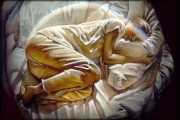Viewings: 6707

Terrible disease, known as lethargy, more than 80 years is a mysterious disease. Doctors cannot safely be called the cause. People lose consciousness and fall asleep. Who for several hours, and who for months and years. Lethargy may come back, but her reason for beginning to be viewed.
The mysterious disease appeared between 1916 and 1927 years and fast worldwide epidemic. Young people, especially women, are the most vulnerable, but the disease has touched people of all ages.
Hundreds of thousands of people died (according to other sources - in the millions), many of the survivors for many years remained "frozen" in their own bodies. Doctors called the disease Encaphilitis Lethargica, which means only "inflammation of the brain, which makes you tired" ("inflammation of the brain that makes you tired").
The cause was a mystery, but the version, of course, were expressed. Some doctors thought lethargy causes unknown virus, other confused it with Spanish flu epidemic, raging in those years, others saw the culprit in some weapons used in World war. But even now, more than 80 years later, scientists are unsure about this very reason to call. Although the epidemic, like, gone in the same 1920s, in 1948, the flash of something like this was fixed in Iceland.
Moreover, in recent years, lethargy (or a disease with similar symptoms) received a lot of other names, for example, Economo's disease, Cruchet's disease and Akureyri disease. This means that some modern cases - and from time to time sleeping sickness makes itself felt - remain undiagnosed.
So, the Professor John Oxford (John Oxford) 'm sure lethargy is not a disease of the past, she can come back. And his fears have been confirmed. For example, in 1993 the English doctors came to the incredible conclusion: a 23-year-old Becky Howells (Becky Howells) suffers from the disease, last seen more than 70 years ago. Professor Oxford was just trying to help her, and from the beginning was convinced that the solution is in the past. He found samples of brain tissue of victims of epidemic of the 1920s and tried to find traces of the virus.
Scientist, like so many of his colleagues, it seemed possible that the epidemic lethargy associated with an outbreak of Spanish influenza. The doctor was looking for traces of a virus or infection, but nothing like finding then failed, and Becky gradually recovered. Here it should be noted that for physicians, unaware of the causes sleeping sickness, it is very difficult to assign a certain cure or prevent disease.
However, modern medicine is fully capable to maintain the patient's breathing, to provide food and to protect from other infections, steroids can help with inflammation in the brain, and so on. Thus, people gradually returns to normal life. In the 1920s doctors it was not under force, because so many deaths. Well, since the beginning of the 1990s was documented several cases of lethargy: four years ago this problem was diagnosed Patricia Vaughan (Patricia Vaughan). Just at that moment two young English doctors - Dale Russell (Russell Dale) and his colleague Andrew Church (Andrew Church) -decided to study the mysterious disease.
According to BBC, the work of these physicians, published a few months ago in a little-known medical journal and not made much noise, may provide a clue to the reason of one of the most dangerous diseases of the XX century.
The first thing Dale and the Church turned for help to the medical community and, in the end, managed to gather data on 20 patients. Then they started to look for something common between all sick and found that many of the patients had quinsy before were impressed by lethargy. Thus, the doctors began to look for traces of a bacterial infection that can cause angina. They were particularly interested in the bacterium Streptococcus (Streptoccus) and "relatives" - diplococci (Diplococcus).
And it turned out that all patients have a rare form just the bacterium Streptococcus. That is, the bacteria that can cause normal sore throat, has changed and has taken the form of provoking the attack Encaphilitis Lethargica. The immune system of some people, abstract attack infection in the throat, transmits the parasite in the nervous system, affect the average brain becomes inflamed. Approximately so.
To check your conjecture, Dr. Dale-new examined the medical archives and found that, first, many victims of the epidemic 1920s also originally quinsy, and, secondly, in the records often mentioned diplococci. Really like what Dale and Church identified the source of the actual cases lethargy and perhaps opened the 80-year-old medical confidentiality - this is the BBC, in fact, reported. But in medical encyclopedia of the same British broadcasting in the section devoted lethargy, these seemingly new information about the Streptococcus long-contained, representing version, called autoimmune disease.
"As no virus has not been found, it is assumed that the syndrome is not caused by incoming and attacking the brain virus, - is said in the encyclopedia. - Maybe your own immune cells attack the nerve cells?". Anyway, Dale and Church continue their research work.
















